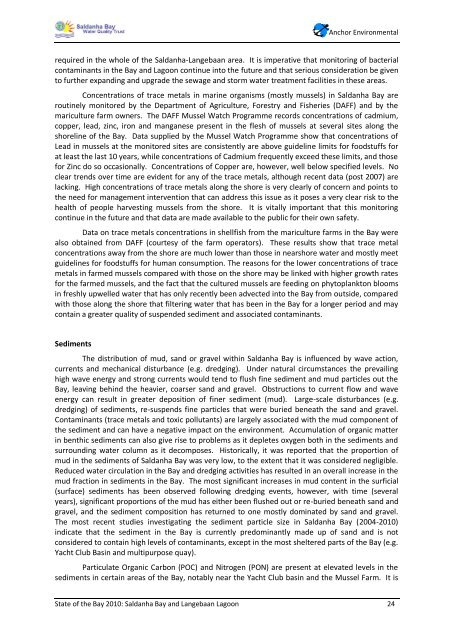State of the Bay Report 2010-Final - Anchor Environmental
State of the Bay Report 2010-Final - Anchor Environmental
State of the Bay Report 2010-Final - Anchor Environmental
You also want an ePaper? Increase the reach of your titles
YUMPU automatically turns print PDFs into web optimized ePapers that Google loves.
<strong>Anchor</strong> <strong>Environmental</strong><br />
required in <strong>the</strong> whole <strong>of</strong> <strong>the</strong> Saldanha-Langebaan area. It is imperative that monitoring <strong>of</strong> bacterial<br />
contaminants in <strong>the</strong> <strong>Bay</strong> and Lagoon continue into <strong>the</strong> future and that serious consideration be given<br />
to fur<strong>the</strong>r expanding and upgrade <strong>the</strong> sewage and storm water treatment facilities in <strong>the</strong>se areas.<br />
Concentrations <strong>of</strong> trace metals in marine organisms (mostly mussels) in Saldanha <strong>Bay</strong> are<br />
routinely monitored by <strong>the</strong> Department <strong>of</strong> Agriculture, Forestry and Fisheries (DAFF) and by <strong>the</strong><br />
mariculture farm owners. The DAFF Mussel Watch Programme records concentrations <strong>of</strong> cadmium,<br />
copper, lead, zinc, iron and manganese present in <strong>the</strong> flesh <strong>of</strong> mussels at several sites along <strong>the</strong><br />
shoreline <strong>of</strong> <strong>the</strong> <strong>Bay</strong>. Data supplied by <strong>the</strong> Mussel Watch Programme show that concentrations <strong>of</strong><br />
Lead in mussels at <strong>the</strong> monitored sites are consistently are above guideline limits for foodstuffs for<br />
at least <strong>the</strong> last 10 years, while concentrations <strong>of</strong> Cadmium frequently exceed <strong>the</strong>se limits, and those<br />
for Zinc do so occasionally. Concentrations <strong>of</strong> Copper are, however, well below specified levels. No<br />
clear trends over time are evident for any <strong>of</strong> <strong>the</strong> trace metals, although recent data (post 2007) are<br />
lacking. High concentrations <strong>of</strong> trace metals along <strong>the</strong> shore is very clearly <strong>of</strong> concern and points to<br />
<strong>the</strong> need for management intervention that can address this issue as it poses a very clear risk to <strong>the</strong><br />
health <strong>of</strong> people harvesting mussels from <strong>the</strong> shore. It is vitally important that this monitoring<br />
continue in <strong>the</strong> future and that data are made available to <strong>the</strong> public for <strong>the</strong>ir own safety.<br />
Data on trace metals concentrations in shellfish from <strong>the</strong> mariculture farms in <strong>the</strong> <strong>Bay</strong> were<br />
also obtained from DAFF (courtesy <strong>of</strong> <strong>the</strong> farm operators). These results show that trace metal<br />
concentrations away from <strong>the</strong> shore are much lower than those in nearshore water and mostly meet<br />
guidelines for foodstuffs for human consumption. The reasons for <strong>the</strong> lower concentrations <strong>of</strong> trace<br />
metals in farmed mussels compared with those on <strong>the</strong> shore may be linked with higher growth rates<br />
for <strong>the</strong> farmed mussels, and <strong>the</strong> fact that <strong>the</strong> cultured mussels are feeding on phytoplankton blooms<br />
in freshly upwelled water that has only recently been advected into <strong>the</strong> <strong>Bay</strong> from outside, compared<br />
with those along <strong>the</strong> shore that filtering water that has been in <strong>the</strong> <strong>Bay</strong> for a longer period and may<br />
contain a greater quality <strong>of</strong> suspended sediment and associated contaminants.<br />
Sediments<br />
The distribution <strong>of</strong> mud, sand or gravel within Saldanha <strong>Bay</strong> is influenced by wave action,<br />
currents and mechanical disturbance (e.g. dredging). Under natural circumstances <strong>the</strong> prevailing<br />
high wave energy and strong currents would tend to flush fine sediment and mud particles out <strong>the</strong><br />
<strong>Bay</strong>, leaving behind <strong>the</strong> heavier, coarser sand and gravel. Obstructions to current flow and wave<br />
energy can result in greater deposition <strong>of</strong> finer sediment (mud). Large-scale disturbances (e.g.<br />
dredging) <strong>of</strong> sediments, re-suspends fine particles that were buried beneath <strong>the</strong> sand and gravel.<br />
Contaminants (trace metals and toxic pollutants) are largely associated with <strong>the</strong> mud component <strong>of</strong><br />
<strong>the</strong> sediment and can have a negative impact on <strong>the</strong> environment. Accumulation <strong>of</strong> organic matter<br />
in benthic sediments can also give rise to problems as it depletes oxygen both in <strong>the</strong> sediments and<br />
surrounding water column as it decomposes. Historically, it was reported that <strong>the</strong> proportion <strong>of</strong><br />
mud in <strong>the</strong> sediments <strong>of</strong> Saldanha <strong>Bay</strong> was very low, to <strong>the</strong> extent that it was considered negligible.<br />
Reduced water circulation in <strong>the</strong> <strong>Bay</strong> and dredging activities has resulted in an overall increase in <strong>the</strong><br />
mud fraction in sediments in <strong>the</strong> <strong>Bay</strong>. The most significant increases in mud content in <strong>the</strong> surficial<br />
(surface) sediments has been observed following dredging events, however, with time (several<br />
years), significant proportions <strong>of</strong> <strong>the</strong> mud has ei<strong>the</strong>r been flushed out or re-buried beneath sand and<br />
gravel, and <strong>the</strong> sediment composition has returned to one mostly dominated by sand and gravel.<br />
The most recent studies investigating <strong>the</strong> sediment particle size in Saldanha <strong>Bay</strong> (2004-<strong>2010</strong>)<br />
indicate that <strong>the</strong> sediment in <strong>the</strong> <strong>Bay</strong> is currently predominantly made up <strong>of</strong> sand and is not<br />
considered to contain high levels <strong>of</strong> contaminants, except in <strong>the</strong> most sheltered parts <strong>of</strong> <strong>the</strong> <strong>Bay</strong> (e.g.<br />
Yacht Club Basin and multipurpose quay).<br />
Particulate Organic Carbon (POC) and Nitrogen (PON) are present at elevated levels in <strong>the</strong><br />
sediments in certain areas <strong>of</strong> <strong>the</strong> <strong>Bay</strong>, notably near <strong>the</strong> Yacht Club basin and <strong>the</strong> Mussel Farm. It is<br />
<strong>State</strong> <strong>of</strong> <strong>the</strong> <strong>Bay</strong> <strong>2010</strong>: Saldanha <strong>Bay</strong> and Langebaan Lagoon 24

















